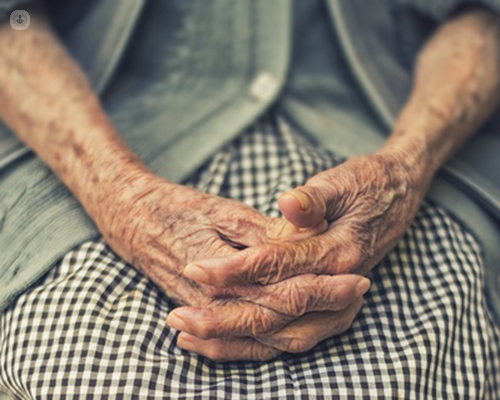


What is gangrene?
Gangrene is tissue death caused by a loss of blood supply, and therefore a lack of oxygen. It is most common in the hands and feet, although muscles and internal organs can become gangrenous as well.
Individuals with diabetes, atherosclerosis and other blood vessel disorders have a higher risk of gangrene.
Gangrene can be classified into:
- Dry gangrene – associated with diabetes, atherosclerosis, and peripheral vascular disease. It is generally caused by critically insufficient blood supply to a limb or to a tissue. It is not associated with bacterial infections.
- Wet gangrene/infected gangrene – caused by a bacterial infection, often in a wound, but can also develop from dry gangrene if the dead tissue becomes infected. The bacteria proliferate and can lead to sepsis.
- Gas gangrene – caused by a bacterial infection, which spreads rapidly as the gases produced by bacteria expand and infiltrate nearby healthy tissue.
Prognosis
Gangrene can become a life-threatening condition if not diagnosed and treated as soon as possible.
Dry gangrene has a higher survival rate as bacteria are unlikely to survive in the tissue, reducing the risk of infection. However, the tissue is not salvageable and often eventually falls off (autoamputation).
Wet gangrene is often deadly. It spreads quickly and can lead to septicaemia (general infection of the body), which can be lethal if you go into septic shock. If infected, dry gangrene can become wet gangrene and follow the same course of complications.
Similarly, gas gangrene spreads quickly and can cause necrosis and sepsis. It should be treated as a medical emergency.
If you have gangrene, you may have to have the affected area amputated.
What are the symptoms of gangrene?
If your skin or limbs are gangrenous, the symptoms may include:
- Redness and swelling (initially)
- All or part of the infected area may turn black, green or brown
- Severe pain or loss of sensation
- Skin becomes cold and pale
- Skin becomes black, dry and shrunken (dry gangrene)
- Sores or blisters with foul-smelling discharge (if infected)
- Foetid smell (wet gangrene)
- Subcutaneous gas – this may cause a crackling sound when pressing the skin (gas gangrene)
There may also be symptoms associated with infections in the case of wet and gas gangrene:
- Accelerated heartbeat
- Rapid breathing
- High temperature
- Dizziness
- Loss of appetite
Sepsis can occur as a result of gangrene, which may result in septic shock. This requires emergency medical attention, as it could result in death. Symptoms of this include:
- Rapid but weak pulse
- Difficulty breathing
- Confusion/disorientation
- Vomiting
- Diarrhoea
- Cold, pale, clammy skin
What causes gangrene?
The main causes for gangrene are:
- Diabetes
- Atherosclerosis
- Peripheral arterial disease
- Raynaud’s – a condition affecting circulation
- Injury, e.g. trauma, burns, frostbite
- Weakened immune system – this could be due to chemotherapy or radiotherapy, infection with HIV, malnutrition, alcohol or drug abuse, obesity, kidney failure, or natural ageing.
How can it be prevented?
Diabetics should monitor their blood glucose concentration periodically. Furthermore, it is important to look after your feet, looking out for problems and having them checked by a doctor at least once a year.
It is advisable to avoid extreme temperatures during the winter - remember to wear heavy socks and gloves during the coldest months.
How is it diagnosed?
The most common diagnostic tools are:
- Blood test
- X-ray scan
- CT scan
- Magnetic resonance imaging (MRI) scan
- Tissue biopsy
- Arteriogram: can determine which artery was obstructed, causing the necrosis
How is gangrene treated?
Gangrene should be treated as soon as possible. Treatment primarily involves removing the dead tissue:
- Amputation – in severe cases a whole body part, e.g. a digit or a limb may need to be removed surgically to prevent the gangrene from spreading.
- Debridement – the surgical removal of tissue. Less extreme than amputation, the infected tissue may be removes surgically or using specially bred and sterilised fly larvae (maggots) to eat the dead tissue. The larvae also release substances that kill bacteria, helping to fight infection.
- Antibiotics to counter infection
- Surgery to restore blood flow – bypass surgery to redirect blood flow and angioplasty to re-open blocked arteries can restore blood flow to the affected area in some cases.
- Hyperbaric oxygen therapy (HBOT) – the patient lies in a hyperbaric chamber, which forces high levels of oxygen into the bloodstream, promoting healing and impeding the bacteria that cause gas gangrene.
Which doctor should I talk to?
Vascular surgeons and dermatologists have expertise in diagnosing and treating gangrene.
